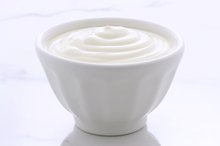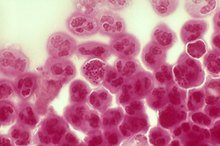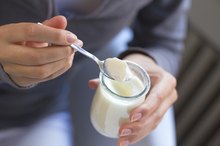What does fact checked mean?
At Healthfully, we strive to deliver objective content that is accurate and up-to-date. Our team periodically reviews articles in order to ensure content quality. The sources cited below consist of evidence from peer-reviewed journals, prominent medical organizations, academic associations, and government data.
- MayoClinic.com: Acidophilus (Lactobacillus Acidophilus)
- MayoClinic.com: Bacterial Vaginosis
- Medline Plus: Lactobacillus
The information contained on this site is for informational purposes only, and should not be used as a substitute for the advice of a professional health care provider. Please check with the appropriate physician regarding health questions and concerns. Although we strive to deliver accurate and up-to-date information, no guarantee to that effect is made.
Baking Soda Paste for Lactobacillus Infections
Lactobacillus, also called Lactobacillus acidophilus, is a type of normal bacteria that lives in the intestine and vagina 14. The bacteria help maintain a normal level of acidity in the vagina. When the amount of Lactobacillus in your vagina increases or decreases, you might develop an infection called bacterial vaginosis 24. Medication is prescribed for a Lactobacillus infection, but home remedies, such as baking soda, might help relieve your symptoms while the medicine fights the infection 4.
If you are experiencing serious medical symptoms, seek emergency treatment immediately.
Lactobacillus
Lactobacillus is a beneficial bacteria that lives in your vagina 4. This strain of bacteria helps prevent vaginal infections by maintaining a healthy acidity level. Lactobacillus also keeps your vagina healthy by preventing harmful bacteria from growing 4. According to MayoClinic.com, applying topical Lactobacillus to the vagina might help treat bacterial vaginosis, a condition that is related to the amount of Lactobacillus in your vagina 124.
Bacterial Vaginosis
Bacterial Vaginosis Home Remedies
Learn More
Bacterial vaginosis is a type of infection that occurs when the balance of bacteria in your vagina is disrupted 2. When harmful bacteria grow and outnumber Lactobacillus, the good bacteria, an infection develops 4. Unprotected sex and frequent douching can increase your risk of developing bacterial vaginosis because these activities can upset your normal bacteria balance 2. Symptoms of bacterial vaginosis include thin, grayish-colored vaginal discharge, a fishy vaginal odor, vaginal itching, pain during intercourse, burning when urinating and vaginal bleeding 2.cause:
- Symptoms of bacterial vaginosis include thin
- grayish-colored vaginal discharge
- a fishy vaginal odor
- vaginal itching
- pain during intercourse
- burning when urinating
- vaginal bleeding 2
Antibiotics are the prescribed course of treatment. These destroy harmful bacteria so your body is able to restore a normal bacteria balance. Certain home remedies might help ease your symptoms, but they will not cure your infection.
Baking Soda
Because a Lactobacillus infection upsets the normal pH balance of your vagina, baking soda can help relieve your symptoms by restoring a normal pH 4. According to the Merck Manual, you should keep your vulva and vaginal area as clean as possible until your infection clears up 3. In addition to avoiding the use of soap, you should not use topical treatments unless your antibiotics are in cream form. Do not use a baking soda paste to relieve your symptoms. Instead, run a bath with baking soda. Sprinkle baking soda into a warm bath and stir with your hand until it is completely dissolved. Soak in the bath and the baking soda might relieve the itching and pain associated with a Lactobacillus infection 4.
Considerations
Does Activia Help With a Yeast Infection?
Learn More
If you develop symptoms of bacterial vaginosis, contact your doctor right away 2. Do not try to treat a Lactobacillus infection on your own 4. Because it is a bacterial infection, antibiotics are necessary to completely rid your body of the infection. During treatment, avoid sexual intercourse and douching. Bacterial vaginosis recurrences are common, MayoClinic.com reports 2. Use protection during intercourse, don't douche and use mild soap to help reduce your risk of a future infection.
Related Articles
References
- MayoClinic.com: Acidophilus (Lactobacillus Acidophilus)
- MayoClinic.com: Bacterial Vaginosis
- The Merck Manual: Vaginitis
- Medline Plus: Lactobacillus
- Miller EA, Beasley DE, Dunn RR, Archie EA. Lactobacilli dominance and vaginal pH: why is the human vaginal microbiome unique?. Front Microbiol. 2016;7:1936. doi:10.3389/fmicb.2016.01936
- Lobo, RA, Gershenson, DM, Lentz, GM, Valea, FA. Comprehensive Gynecology. New York, NY: Elsevier Health Sciences; 2016.
- Heczko PB, Tomusiak A, Adamski P, et al. Supplementation of standard antibiotic therapy with oral probiotics for bacterial vaginosis and aerobic vaginitis: a randomised, double-blind, placebo-controlled trial. BMC Womens Health. 2015;15:115. doi:10.1186/s12905-015-0246-6
- De Alberti D, Russo R, Terruzzi F, Nobile V, Ouwehand AC. Lactobacilli vaginal colonisation after oral consumption of Respecta(®) complex: a randomised controlled pilot study. Arch Gynecol Obstet. 2015 Oct;292(4):861-7. doi:10.1007/s00404-015-3711-4.
- Murina F, Graziottin A, Vicariotto F, De Seta F. Can Lactobacillus fermentum LF10 and Lactobacillus acidophilus LA02 in a slow-release vaginal product be useful for prevention of recurrent vulvovaginal candidiasis?: A clinical study. J Clin Gastroenterol. 2014 Nov-Dec;48 Suppl 1:S102-5. doi:10.1097/MCG.0000000000000225.
- Vodstrcil LA, Walker SM, Hocking JS, Law M, Forcey DS, Fehler G, Bilardi JE, Chen MY, Fethers KA, Fairley CK, Bradshaw CS. Incident bacterial vaginosis (BV) in women who have sex with women is associated with behaviors that suggest sexual transmission of BV. Clin Infect Dis. 2015 Apr 1;60(7):1042-53. doi:10.1093/cid/ciu1130.
- Boskey ER, Cone RA, Whaley KJ, Moench TR. Origins of vaginal acidity: high D/L lactate ratio is consistent with bacteria being the primary source. Hum Reprod. 2001 Sep;16(9):1809-13.
- Boskey ER, Telsch KM, Whaley KJ, Moench TR, Cone RA. Acid production by vaginal flora in vitro is consistent with the rate and extent of vaginal acidification. Infect Immun. 1999 Oct;67(10):5170-5.
- Recine N, Palma E, Domenici L, Giorgini M, Imperiale L, Sassu C, Musella A, Marchetti C, Muzii L, Benedetti Panici P. Restoring vaginal microbiota: biological control of bacterial vaginosis. A prospective case-control study using Lactobacillus rhamnosus BMX 54 as adjuvant treatment against bacterial vaginosis. Arch Gynecol Obstet. 2015 Jul 5.
- Taha TE, Hoover DR, Dallabetta GA, Kumwenda NI, Mtimavalye LA, Yang LP, Liomba GN, Broadhead RL, Chiphangwi JD, Miotti PG. Bacterial vaginosis and disturbances of vaginal flora: association with increased acquisition of HIV. AIDS. 1998 Sep 10;12(13):1699-706.
Writer Bio
Sara Ipatenco has taught writing, health and nutrition. She started writing in 2007 and has been published in Teaching Tolerance magazine. Ipatenco holds a bachelor's degree and a master's degree in education, both from the University of Denver.









